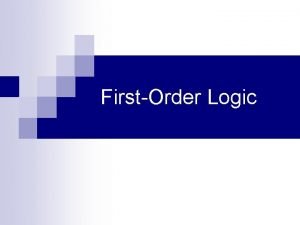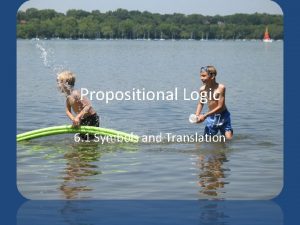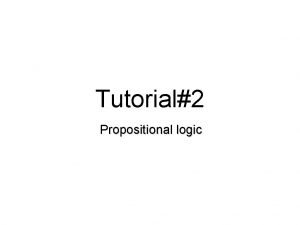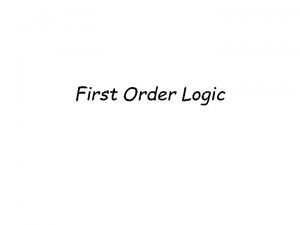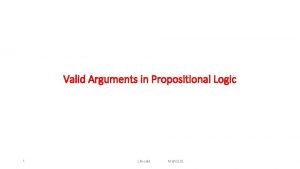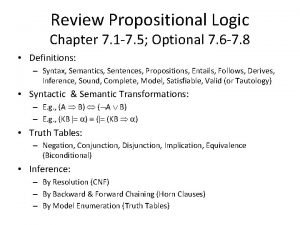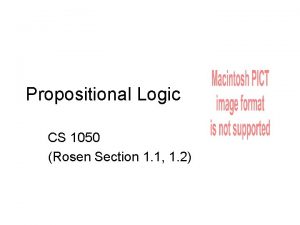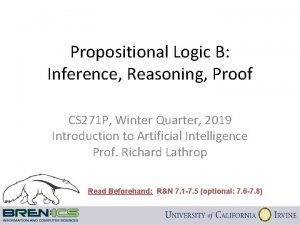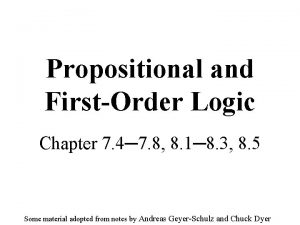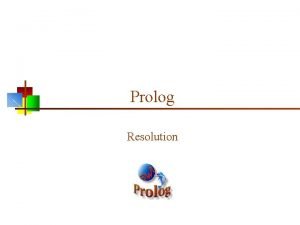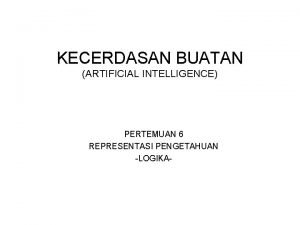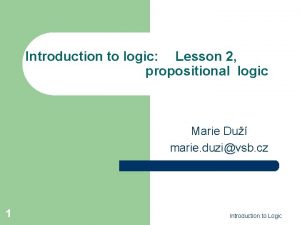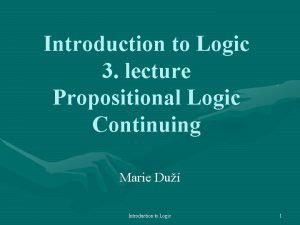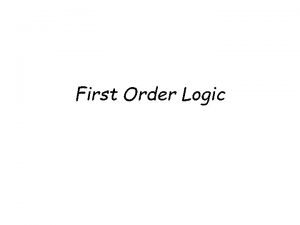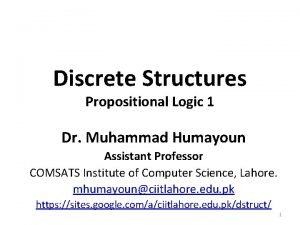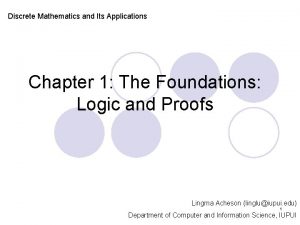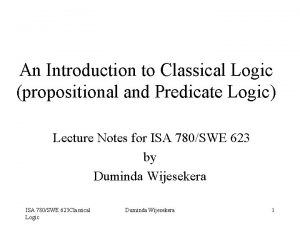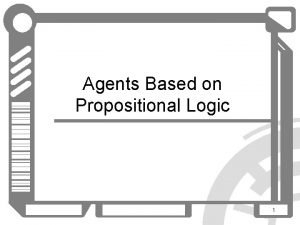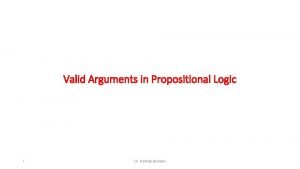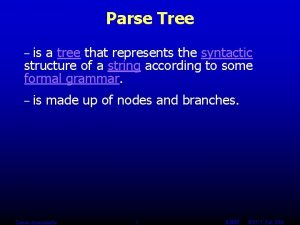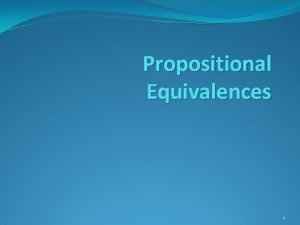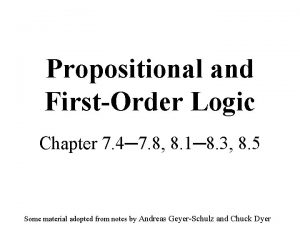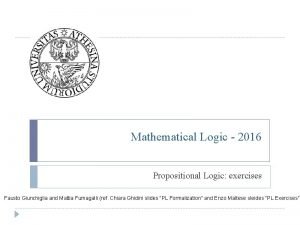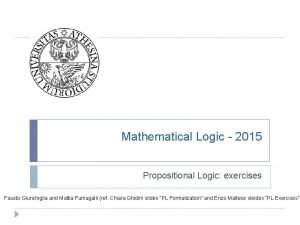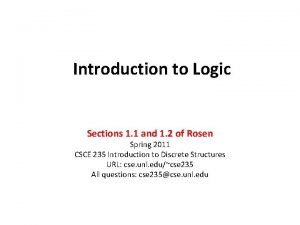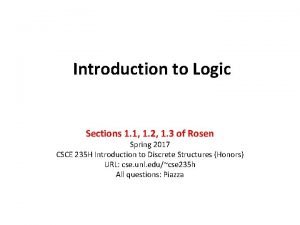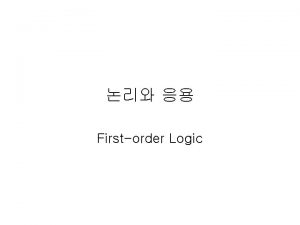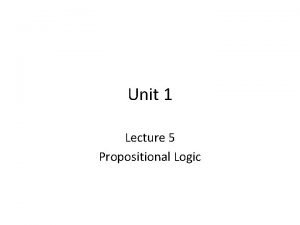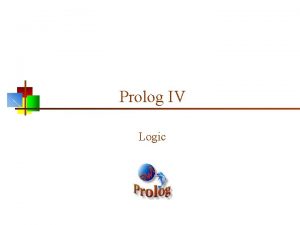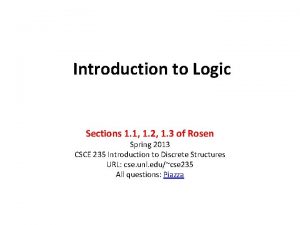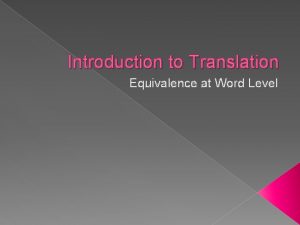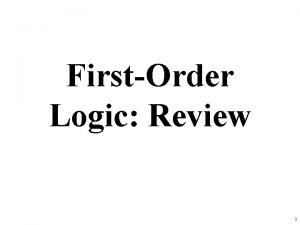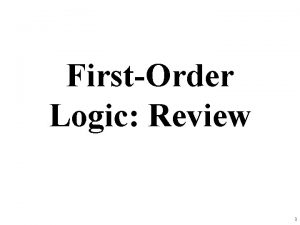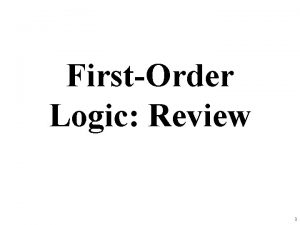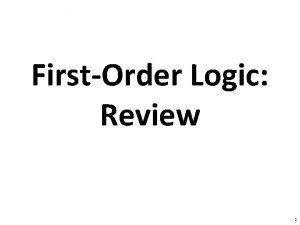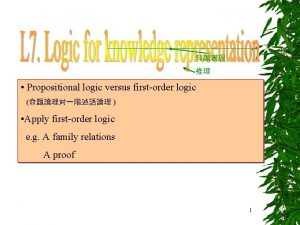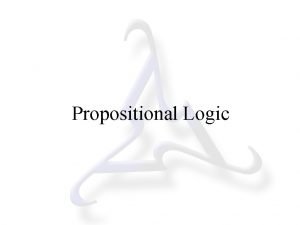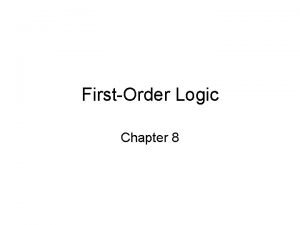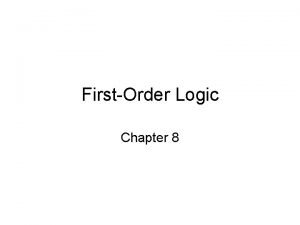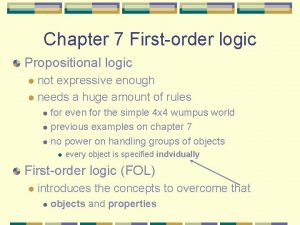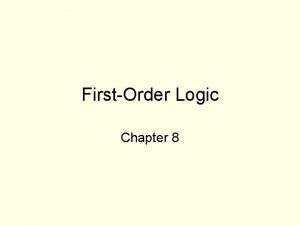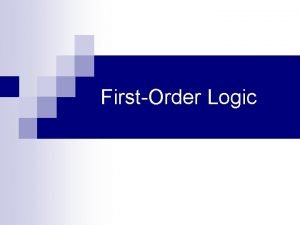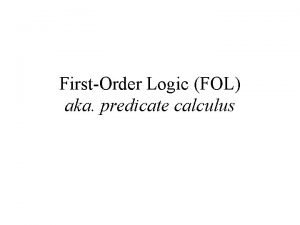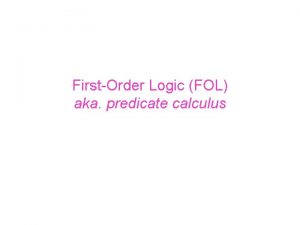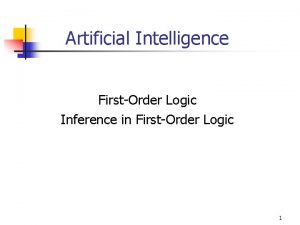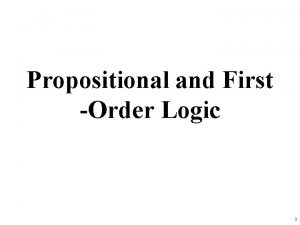Propositional and FirstOrder Logic Chapter 7 47 8









![Models for a KB • KB: [P Q R, Q P] • What are Models for a KB • KB: [P Q R, Q P] • What are](https://slidetodoc.com/presentation_image_h/00fb71703fbe0c66c8c37922c77a36d8/image-10.jpg)





























- Slides: 39

Propositional and First-Order Logic Chapter 7. 4─7. 8, 8. 1─8. 3, 8. 5 Some material adopted from notes by Andreas Geyer-Schulz and Chuck Dyer

Logic roadmap overview • Propositional logic – Problems with propositional logic • First-order logic – Properties, relations, functions, quantifiers, … – Terms, sentences, wffs, axioms, theories, proofs, … – Extensions to first-order logic • Logical agents – Reflex agents – Representing change: situation calculus, frame problem – Preferences on actions – Goal-based agents

Disclaimer “Logic, like whiskey, loses its beneficial effect when taken in too large quantities. ” - Lord Dunsany

Propositional Logic: Review

Big Ideas • Logic is a great knowledge representation language for many AI problems • Propositional logic is the simple foundation and fine for many AI problems • First order logic (FOL) is much more expressive as a knowledge representation (KR) language and more commonly used in AI • Variations on FOL are common: horn logic, higher order logic, three-valued logic, probabilistic logic, fuzzy logic, etc.

Propositional logic syntax • Logical constants: true, false • Propositional symbols: P, Q, . . . (aka atomic sentences) • Parentheses: ( … ) • Sentences are build with connectives: and [conjunction] or [disjunction] implies [implication/conditional/if] is equivalent [biconditional/iff] not [negation] • Literal: atomic sentence or their negation: P, P

Propositional logic syntax • Simplest logic language in which a user specifies – Set of propositional symbols (e. g. , P, Q) – What each means, e. g. : P: “It’s hot”, Q: “It’s humid” • A sentence (well formed formula) is defined as: – Any symbol is a sentence – If S is a sentence, then S is a sentence – If S is a sentence, then (S) is a sentence – If S and T are sentences, then so are (S T), and (S ↔ T) – A sentence results from a finite number of applications of the rules

Examples of PL sentences • (P Q) R “If it is hot and humid, then it is raining” • Q P “If it is humid, then it is hot” • Q “It is humid. ” • We’re free to choose better symbols, e. g. : Hot = “It is hot” Humid = “It is humid” Raining = “It is raining”

Some terms • The meaning or semantics of a sentence determines its interpretation • Given the truth values of all symbols in a sentence, it can be evaluated to determine its truth value (True or False) • A model for a KB is a possible world – an assignment of truth values to propositional symbols that makes each KB sentence true
![Models for a KB KB P Q R Q P What are Models for a KB • KB: [P Q R, Q P] • What are](https://slidetodoc.com/presentation_image_h/00fb71703fbe0c66c8c37922c77a36d8/image-10.jpg)
Models for a KB • KB: [P Q R, Q P] • What are the sentences? – P Q R –Q P • What are the propositional variables? – P, Q, R • What are the possible models? – Consider all possible assignments of T|F to P, Q, R – Check truth tables for consistency P: it's hot Q: it's humid R: it's raining PQR F F F : OK F F T : OK F T F : NO F T T : NO T F F : OK T F T : OK T T F : NO T T T : OK

Models for a KB • Add Q to the KB • KB: [P Q R, Q P, Q] • What are the sentences? – P Q R –Q P –Q • What are the propositional variables? – P, Q, R • What are the possible models? – Consider all possible assignments of T|F to P, Q, R – Check truth tables for consistency P: it's hot Q: it's humid R: it's raining PQR F F F : OK F F T : OK F T F : NO F T T : NO T F F : NO T F T : NO T T F : NO T T T : OK Since P & R are true in every KB model, the KB entails that P & R are True

More terms • A valid sentence or tautology is a sentence that’s True under all interpretations, no matter what the world is actually like or what the semantics is. Example: “It's raining or it's not raining” • An inconsistent sentence or contradiction is a sentence that’s False under all interpretations. The world is never like what it describes, as in “It's raining and it's not raining. ” • P entails Q, written P |= Q, means that whenever P is True, so is Q – In all models in which P is true, Q is also true

Truth tables • Truth tables are used to define meaning of logical connectives • And to determine when a complex sentence is true given the values of the symbols in it Truth tables for the five logical connectives Example of a truth table used for a complex sentence

The implies connective: P Q • is a logical connective • So P Q is a logical sentence and has a truth value, i. e. , is either true or false • If we add this sentence to a KB, it can be used by an inference rule, Modes Ponens, to derive/infer/prove Q if P is also in the KB • Given a KB where P=True and Q=True, we can derive/infer/prove that P Q is True • Note: P Q is equivalent to ~P Q

P Q • When is P Q true? Check all that apply q P=Q=true q P=Q=false q P=true, Q=false q P=false, Q=true

P Q • When is P Q true? Check all that apply ✔ P=Q=true q ✔ P=Q=false q q P=true, Q=false ✔ P=false, Q=true q • We can get this from the truth table for • Note: in FOL it's much harder to prove that a conditional true, e. g. , prime(x) odd(x)

Inference rules • Logical inference creates new sentences that logically follow from a set of sentences (KB) • An inference rule is sound if every sentence X it produces when operating on a KB logically follows from the KB – i. e. , inference rule creates no contradictions • An inference rule is complete if it can produce every expression that logically follows from (is entailed by) the KB – Note analogy to complete search algorithms

Sound rules of inference Here are examples of sound rules of inference Each can be shown to be sound using a truth table RULE PREMISE CONCLUSION Modus Ponens And Introduction And Elimination Double Negation Unit Resolution A, A B A, B A B A A B, B C B A A A A C

Resolution • Resolution is a valid inference rule producing a new clause implied by two clauses containing complementary literals Literal: atomic symbol or its negation, i. e. , P, ~P • Amazingly, this is the only interference rule needed to build a sound & complete theorem prover – Based on proof by contradiction, usually called resolution refutation • The resolution rule was discovered by Alan Robinson (CS, U. of Syracuse) in the mid 1960 s

Resolution • A KB is a set of sentences all of which are true, i. e. , a conjunction of sentences • To use resolution, put KB into conjunctive normal form (CNF) – Each sentence is a disjunction of one or more literals (positive or negative atoms) • Every KB can be put into CNF, it's just a matter of rewriting its sentences using standard tautologies, e. g. : – P Q ≡ ~P Q

Resolution Example Tautologies (A B) ↔ (~A B) (A (B C)) ↔ (A B) (A C) • KB: [P Q , Q R S] • KB: [P Q , Q R, Q S ] • KB in CNF: [~P Q , ~Q R , ~Q S] • Resolve KB[0] and KB[1] producing: ~P R (i. e. , P R) • Resolve KB[0] and KB[2] producing: ~P S (i. e. , P S) • New KB: [~P Q , ~Q R, ~Q S, ~P R, ~P S]

Soundness of resolution inference rule From rightmost three columns of truth table, we see that (α β) (~β γ) (α γ) is valid (i. e. , always true regardless of truth values for α, β and γ

Proving it’s raining (1) • A proof is a sequence of sentences, where each is a premise (i. e. , a given) or is derived from earlier sentences in the proof by an inference rule • Last sentence is theorem (also called goal or query) that we want to prove • The weather problem using traditional reasoning 1 Hu 2 Hu Ho 3 Ho 4 (Ho Hu) R 5 Ho Hu 6 R premise modus ponens(1, 2) premise and introduction(1, 3) modus ponens(4, 5) “It's humid” “If it's humid, it's hot” “If it's hot & humid, it's raining” “It's hot and humid” “It's raining”

Proving it’s raining (2) Hu Hu => Ho Hu ∧ Ho => R ~(Hu ∧ Ho) ∨ R ~Hu ∨ ~Ho ∨ R Hu ~Hu∨Ho ~Hu∨~Ho∨R Ho Hu => R ~Hu∨R R

A simple proof procedure This procedure generates new sentences from a KB 1. Convert all sentences in the KB to CNF 2. Find all pairs of sentences in KB with complementary literals that have not yet been resolved 3. If there are no pairs stop else resolve each pair, adding the result to the KB and go to 2 • Is it sound? • Is it complete? • Will it always terminate?

Resolution refutation 1. Add negation of goal to the KB 2. Convert all sentences in KB to CNF 3. Find all pairs of sentences in KB with complementary literals that have not yet been resolved 4. If there are no pairs stop else resolve each pair, adding the result to the KB and go to 2 • If we derived an empty clause (i. e. , a contradiction) then the conclusion follows from the KB • If we did not, the conclusion cannot be proved from the KB

Horn* sentences • A Horn sentence or Horn clause has the form: P 1 P 2 P 3. . . Pn Qm where n>=0, m in{0, 1} • Note: a conjunction of 0 or more symbols to left of and 0 -1 symbols to right • Special cases: – n=0, m=1: P (assert P is true) – n>0, m=0: P Q (constraint: both P and Q can’t be true) – n=0, m=0: (well, there is nothing there!) • Put in CNF: each sentence is a disjunction of literals with at most one non-negative literal P 1 P 2 P 3. . . Pn Q * After Alfred Horn (P Q) = ( P Q)

Significance of Horn logic • We can also have horn sentences in FOL • Reasoning with horn clauses is much simpler – Satisfiability of propositional KB (i. e. , finding values for a symbols that will make it true) is NP complete – Restricting KB to horn sentences, satisfiability is in P • For this reason, FOL Horn sentences are the basis for many rule-based languages, including Prolog and Datalog • Horn logic can’t handle, in a general way, negation and disjunctions

Problems with Propositional Logic

Propositional logic: pro and con • Advantages – Simple KR language good for many problems – Lays foundation for higher logics (e. g. , FOL) – Reasoning is decidable, though NP complete; efficient techniques exist for many problems • Disadvantages – Not expressive enough for most problems – Even when it is, it can very “un-concise”

PL is a weak KR language • Hard to identify individuals (e. g. , Mary, 3) • Can’t directly represent properties of individuals or relations between them (e. g. , “Bill is tall”) • Generalizations, patterns, regularities hard to represent (e. g. , “all triangles have 3 sides”) • First-Order Logic (FOL) represents this information via relations, variables & quantifiers, e. g. , • Every elephant is gray: x (elephant(x) → gray(x)) • There is a black swan: x (swan(X) ^ black(X))

PL Example • Consider the problem of representing the following information: – Every person is mortal. – Confucius is a person. – Confucius is mortal. • How can these sentences be represented so that we can infer the third sentence from the first two?

PL Example • In PL we must create propositional symbols to stand for all or part of each sentence, e. g. : P = “person”; Q = “mortal”; R = “Confucius” • The above 3 sentences are represented as: P Q; R P; R Q • The 3 rd sentence is entailed by the first two, but we need an explicit symbol, R, to represent an individual, Confucius, who is a member of the classes person and mortal • Representing other individuals requires introducing separate symbols for each, with some way to represent the fact that all individuals who are “people” are also “mortal”

Hunt the Wumpus domain • Some atomic propositions: S 12 = There is a stench in cell (1, 2) B 34 = There is a breeze in cell (3, 4) W 22 = Wumpus is in cell (2, 2) V 11 = We’ve visited cell (1, 1) OK 11 = Cell (1, 1) is safe … • Some rules: S 22 W 12 W 23 W 32 W 21 B 22 P 12 P 23 P 32 P 21 W 22 S 12 S 23 W 21 W 22 W 11 W 21 … W 44 A 22 V 22 A 22 W 11 W 21 … W 44 V 22 OK 22

Hunt the Wumpus domain • Eight variables for each cell, i. e. : A 11, B 11, G 11, OK 11, P 11, S 11, V 11, W 11 • Lack of variables requires giving similar rules for each cell! • Ten rules (I think) for each A 11 … V 11 … P 11 … W 11 … S 11 … B 11 …

After third move • We can prove that the Wumpus is in (1, 3) using these four rules • See R&N section 7. 5 (R 1) S 11 W 11 W 12 W 21 (R 2) S 21 W 11 W 22 W 31 (R 3) S 12 W 11 W 12 W 22 W 13 (R 4) S 12 W 13 W 12 W 22 W 11

Proving W 13 (R 1) S 11 W 11 W 12 W 21 (R 2) S 21 W 11 W 22 W 31 (R 3) S 12 W 11 W 12 W 22 W 13 (R 4) S 12 W 13 W 12 W 22 W 11 Apply MP with S 11 and R 1: W 11 W 12 W 21 Apply And-Elimination to this, yielding 3 sentences: W 11, W 12, W 21 Apply MP to ~S 21 and R 2, then apply And-elimination: W 22, W 21, W 31 Apply MP to S 12 and R 4 to obtain: W 13 W 12 W 22 W 11 Apply Unit Resolution on (W 13 W 12 W 22 W 11) and W 11: W 13 W 12 W 22 Apply Unit Resolution with (W 13 W 12 W 22) and W 22: W 13 W 12 Apply Unit Resolution with (W 13 W 12) and W 12: W 13 QED

Propositional Wumpus hunter problems • Lack of variables prevents stating more general rules, like these: • x, y V(x, y) → OK(x, y) • x, y S(x, y) → W(x-1, y) W(x+1, y) … • Change of the KB over time is difficult to represent – In classical logic, a fact is true or false for all time – A standard technique is to index dynamic facts with the time when they’re true • A(1, 1, t 0) – Thus we have a separate KB for every time point

Propositional logic summary • Inference: process of deriving new sentences from old – Sound inference derives true conclusions given true premises – Complete inference derives all true conclusions from a set of premises • Valid sentence: true in all worlds under all interpretations • If an implication sentence can be shown to be valid, then, given its premise, its consequent can be derived • Different logics make different commitments about what the world is made of and the kind of beliefs we can have • Propositional logic commits only to existence of facts that may or may not be the case in the world being represented – Simple syntax and semantics suffices to illustrate the process of inference – Propositional logic can become impractical, even for very small worlds
 First order logic vs propositional logic
First order logic vs propositional logic First order logic vs propositional logic
First order logic vs propositional logic Third order logic
Third order logic Pros and cons of propositional logic
Pros and cons of propositional logic Logic statements symbols
Logic statements symbols Propositional logic examples and solutions
Propositional logic examples and solutions Compound proposition
Compound proposition Arguments in logic
Arguments in logic Xor in propositional logic
Xor in propositional logic Proposition in mathematics
Proposition in mathematics Xor in propositional logic
Xor in propositional logic Propositional logic notation
Propositional logic notation Implies in propositional logic
Implies in propositional logic Proposition examples sentences
Proposition examples sentences Propotional logic dapat digunakan untuk..
Propotional logic dapat digunakan untuk.. Implies in propositional logic
Implies in propositional logic Propositional logic notation
Propositional logic notation Logic
Logic Discrete math propositional logic
Discrete math propositional logic Propositional logic puzzles
Propositional logic puzzles In triangle pqr
In triangle pqr Xor in propositional logic
Xor in propositional logic Implies in propositional logic
Implies in propositional logic Agents based on propositional logic
Agents based on propositional logic Valid arguments in propositional logic
Valid arguments in propositional logic Parse tree example
Parse tree example De morgan's second theorem truth table
De morgan's second theorem truth table Propositional logic symbols
Propositional logic symbols Propositional logic exercises
Propositional logic exercises Propositional logic exercises
Propositional logic exercises Logically equivalent statements
Logically equivalent statements Logical equivalence cheat sheet
Logical equivalence cheat sheet Propositional logic
Propositional logic Kinship domain in artificial intelligence
Kinship domain in artificial intelligence Simple proposition
Simple proposition Proposition examples sentences
Proposition examples sentences P double implies q is equivalent to
P double implies q is equivalent to Non equivalence at word level
Non equivalence at word level Combinational logic circuit vs sequential
Combinational logic circuit vs sequential Tw
Tw



